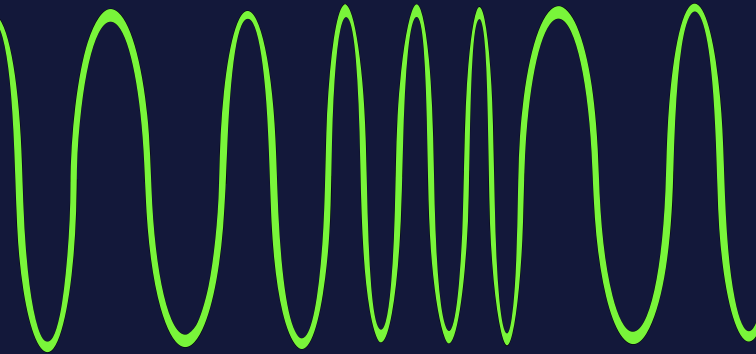What Is a Waveform?
At its core, every radio signal is a waveform — a repeating oscillation of energy, typically graphed as a sine wave. These oscillations vary over time in three key ways:
Amplitude – height of the wave (volume or strength)
Frequency – how fast the wave repeats (pitch or tone)
Phase – the wave’s position in time (like shifting a ripple left/right)
When you modulate a radio wave (to carry voice, text, or data), you change one or more of these properties.
Types of Modulation: How Waveforms Carry Information
Here’s how each type of modulation affects the shape of the wave:
|
Modulation Type |
What Changes |
What It Means |
|---|---|---|
| AM (Amplitude Modulation) | Height of wave (amplitude) | Louder voice = taller wave |
| FM (Frequency Modulation) | Spacing of waves (frequency) | Higher pitch = tighter spacing |
| PM (Phase Modulation) | Time position (phase) | Changes timing between wave crests |
| SSB (Single Sideband) | Removes parts of the AM signal | Saves power & space |
| Digital Modes | Encodes binary in wave shift | 1's and 0's become pattern changes |
Visualizing Waveforms
Let’s picture an unmodulated sine wave (the “carrier”):
Now let’s see how modulation alters it:
AM (amplitude modulation):
Higher peaks for louder voice
Lower peaks for quieter voice
fm (frequency modulation):
pm (phase modulation):
Wave spacing gets tighter or wider
Wave gets "pushed" left or right in time
These differences allow your radio to extract meaning — voice, beeps, or digital info — from what looks like simple wiggles!
Sidebands and Carrier Suppression
When you modulate a signal (especially in AM), extra signals appear on either side of your original frequency. These are called sidebands.
Carrier – the main center frequency
Upper Sideband (USB) – frequencies above the carrier
Lower Sideband (LSB) – frequencies below the carrier
In standard AM, you transmit:
The carrier (which carries no information)
Both sidebands (which carry the same info)
That’s inefficient. So Single Sideband (SSB) removes:
One sideband
The carrier
This results in more efficient use of power and spectrum.
Harmonics: The "Echoes" of Waves
Harmonics are multiples of a signal’s frequency, like echoes at 2x, 3x, 4x the original pitch.
Some harmonics are natural and help with sound quality (like in music)
In radio, unwanted harmonics cause interference (QRM)
Radios use filters to suppress harmonics and keep the signal clean
Example: If you transmit on 7.200 MHz, a poorly filtered transmitter might also emit:
14.400 MHz (2nd harmonic)
21.600 MHz (3rd harmonic)
...which could bleed into other bands.
Summary Table
|
Concept |
Meaning |
Why It Matters |
|---|---|---|
| Carrier Wave | Steady unmodulated sign wave | Base frequency for modulation |
| Amplitude Change | Height of wave varies (AM) | Volume info for voice |
| Frequency Change | Spacing of waves varies (FM) | Pitch/speed info, less prone to noise |
| Phase Change | Wave shifts in time (PM, digital modes) | Encodes data, subtle change |
| Sidebands | Frequencies added by modulation | Carry actual information in AM/SSB |
| Carrier Suppresion | Removing unneeded center frequency | More efficient SSB signal |
| Harmonics | Unwanted multiples of original frequency | Need to be filtered to avoid interference |
Animated GIFs of Modulated Waveforms
Amplitude Modulation (AM) and Frequency Modulation (FM): This blog post provides animations illustrating how AM and FM signals are modulated.
Modulation Animation Tool: Explore different modulation types (AM, FM, PM) and their effects on waveforms using this interactive modulation animation tool.
Web-Based Waveform Sandbox
Virtual Oscilloscope: This Virtual Oscilloscope lets you input different signals and observe their waveforms, mimicking a real oscilloscope's functionality.
Printable Reference Sheet
Waveforms and Spectra: This resource offers diagrams of amplitude modulation waveforms in both time and frequency domains, which can be printed for study.




